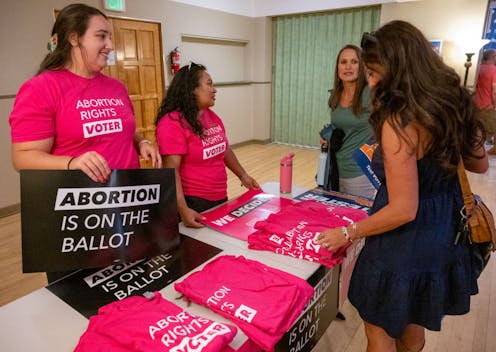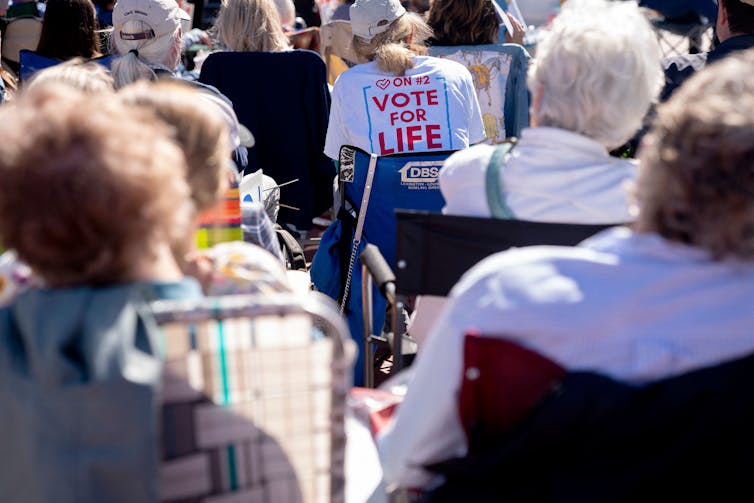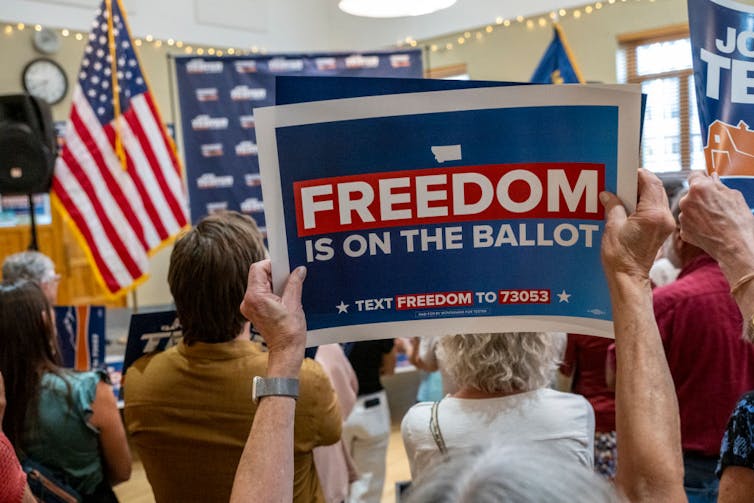Abortion rights are on 10 state ballots in November − Democrats can’t count on this to win elections
Arizona, Florida, New York and Nevada are among the states with upcoming abortion ballot initiatives. Democrats are counting on these ballot measures to help swing elections away from GOP candidates.

Ten states will vote on ballot initiatives on abortion this November: Arizona, Colorado, Florida, Maryland, Missouri, Montana, Nebraska, New York, Nevada and South Dakota.
Many political analysts and pundits view abortion as a partisan issue, fueling speculation that direct votes on abortion rights will boost Democrats’ chances up and down the ballot in November. Some Democratic strategists are hoping that turnout from the ballot initiatives will swing elections away from Republican candidates in key states such as Arizona, Nevada and Florida.
But the effects that ballot measures have on which candidates win or lose is rarely so straightforward.
For the past three years, my work as a political sociologist has been cataloging and studying ballot initiatives. Based on state-level data and recent trends, I believe it is highly likely that many of November’s ballot initiatives to protect abortion rights will pass. But that will not necessarily translate into broader Democratic candidate victories.

The wave of abortion rights votes
The U.S. Supreme Court overturned half a century of federal abortion protections in June 2022, sending the question of whether and when people can get an abortion back to individual states to decide. Republican legislators in Kansas quickly seized the opportunity and rushed a referendum enabling them to ban abortion onto the August 2022 primary ballot.
It backfired. Despite being majority Republican, almost 60% of Kansas voters rejected the abortion ban.
In 2022 and 2023, voters in six more states protected abortion rights with ballot initiatives. Kentucky and Montana voters rejected abortion bans, while California, Michigan, Ohio and Vermont voted to codify abortion rights in their state constitutions, all through ballot measures.
Ballot initiatives are nonpartisan
Ballot initiatives – also called propositions, measures, referendums and more – refer to votes on a policy instead of a politician. In some states, voters can put initiatives on the ballot by gathering signatures. In all states except one – Delaware – state legislators can put issues directly before voters in the form of a referendum. In other instances, such as amending most state constitutions, decisions must go to a popular vote.
The media often portrays U.S. politics through a polarized, two-party lens. Ballot initiatives do not necessarily fit the mold. Ballot initiative votes on topics such as the minimum wage and Medicaid expansion show that some policies are popular across Democratic and Republican party affiliations. For example, raising the minimum wage is undefeated in 24 ballot initiatives at the state level since 1996, including in traditionally conservative, liberal and swing states.
The state ballots that wound up serving wins on abortion rights since 2022 reflect a similar dynamic. The issue is polarizing, but not down the middle and not strictly along party lines. Nationwide polls show long-standing majority support for abortion rights, including among many Republicans.
Inconclusive at best
There is research indicating that ballot initiatives can increase voter turnout. However, most studies show mixed results and limited effects.
Looking at turnout numbers in the 2022 and 2023 state elections that had votes on abortion rights, and comparing them with those same states’ previous election numbers, we don’t see compelling evidence for the ballot measures bringing out more voters.
Michigan and Vermont had increased turnout in 2022, while voter numbers decreased in California, Kentucky and Montana.
Kansas in 2022 and Ohio in 2023 both saw voter gains, but those votes are poor comparisons, because they took place in a primary and an odd-year election, respectively, when turnout tends to be low.
Ballot initiatives on abortion rights, whether to codify or ban them, also appear to have little impact on partisan elections. After defeating the abortion ban in August 2022, Kansas voters went on to reelect both the Democratic incumbent governor and a Republican incumbent senator that November. Kansas House seats remained unchanged, with Republicans holding a supermajority.
In Kentucky and Montana, a majority of voters rejected abortion bans in 2022 and continued to elect Republicans to state office. In Michigan, Democrats took control of the state Legislature in 2022 alongside the state’s vote for abortion rights.
It is possible that Michigan’s “blue wave” in 2022 got a boost from the state’s ballot initiative to protect abortion rights that year. However, it likely had more to do with direct legislation from the previous election. In 2018, Michigan voters passed a ballot initiative to create an independent redistricting commission that undid years of gerrymandering that had benefited Republicans. These redrawn maps were first used in 2022.
Most importantly, just because a voter cares deeply about abortion rights does not necessarily mean they will vote for Democrats. Republican women voters overwhelmingly support the right to abortion in all states.
Meanwhile, about 6% of voters chose “uncommitted” in Nevada’s 2024 Democratic primary, in line with the national uncommitted movement in solidarity with Palestinians. This political movement advocates withholding support for Democrats over the Biden administration’s support for Israel’s war in Gaza. Those voters are highly likely to support the state’s abortion initiative in November but may not be persuaded to vote for Democratic presidential candidate Kamala Harris or other Democrats.

Democrats can’t rely on abortion ballot initiatives
Ballot initiatives are about specific issues, not political candidates. In this case, the issue of abortion rights has more nationwide support than the Democratic Party does.
If Democratic politicians want to win in November – from Harris and Tim Walz to state and local candidates – they will need to persuade voters based on their merits compared with their Republican counterparts. They can’t count on abortion initiatives to win the 2024 election for them.
Benjamin Case does not work for, consult, own shares in or receive funding from any company or organization that would benefit from this article, and has disclosed no relevant affiliations beyond their academic appointment.
Read These Next
RFK Jr. wants to scrutinize the vaccine schedule – but its safety record is already decades long
Federal officials are questioning the safety of the vaccine series children receive. Here’s the story…
Deception and lies from the White House to justify a war in Venezuela? We’ve seen this movie before
Two US wars based on lies, in which tens of thousands of American troops and millions of civilians died,…
Miami’s new mayor faces a housing affordability crisis, city charter reform and a shrinking budget
Eileen Higgins won a hard-fought election to become Miami’s new mayor. Now for the hard part – governing…






